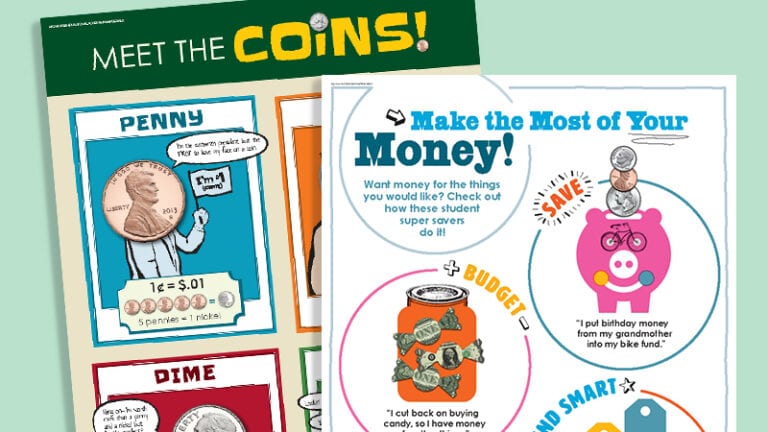Victoria DeOrnellis’ story is an oh-so familiar one. She grew up in a middle-class family, accustomed to a comfortable lifestyle. She attended college for a few years, then left to get married and, shortly thereafter, had a child. “As a married couple,” Victoria says, “we made some spectacularly bad choices.”
Having never learned budgeting skills (financial literacy had not been part of her school curriculum), Victoria and her husband soon found themselves living beyond their means and struggling to pay the bills. At a particularly low point, they even had their car repossessed.
After a few short years, Victoria’s marriage ended and she found herself a struggling single parent. She returned to school and earned her college degree in education. In January of 2003, she landed her first teaching job, with a salary of just $26,000. “I struggled to make ends meet,” Victoria says. “I had to figure out how to make a very limited budget work.” By this time she was receiving child support payments and had a steady (but not huge) income to work with. Still, she experienced many stressful years of shuffling bills around to pay them all, and not always on time.
Victoria was determined to set herself on a course of financial self-improvement. Her goal was to create a life within her means for herself and her son. Victoria learned how to budget and make better choices. When she was short on money, she found ways to get more. She held yard sales and took a second job tutoring. She went back to school once again and earned her master’s degree, which translated to a higher salary. It wasn’t immediate, but eventually, with hard work, determination and a plan, Victoria was redefining her financial path.
Wanting better for her students
Victoria teaches gifted students in grades 2–8 at a small Title I school in Mississippi. Many of her students’ families struggle to make ends meet and never learned financial literacy skills. Looking back at the mistakes she made starting out, she tells us she wishes she had been more prepared with real-life skills. She feels passionately about providing her students with a stronger foundation than the one she received.
Victoria takes a bravely honest approach with her students. “Y’all just don’t know how many stupid things I’ve done,” she tells them. “I want to be honest with you about the choices I’ve made. If that’ll help you make better choices, then I’ll feel successful. Hopefully my story will save you from some pain. Because you just don’t know—when you can’t pay the bills, it’s really stressful.” She believes in her students’ potential and hopes to teach them financial literacy skills that will enable them to live stable and fulfilling lives. Her best advice? “You have to have discipline, and you have to have a plan.”
Teaching financial literacy in the classroom
Victoria believes that the earlier she can equip her students with a solid foundation of financial literacy skills the better. She introduces basic concepts, such as needs vs. wants, making smart choices with money, and the importance of saving, to her elementary students. In addition, she uses every opportunity to tie financial literacy into other subjects. Her hope is that repeated exposure to financial literacy concepts from an early age will help her students graduate well prepared for real life.
The Vault – Understanding Money resource, designed for elementary students, features six digital lessons covering needs vs. wants, money management, and income and careers. Learn more.
Victoria’s seventh and eighth graders take part in a “Real World” unit she designed to focus on important financial principles to give them hands-on practice with money skills. First each student is set up with a life scenario, including career, home, family, and fixed vs. variable monthly expenses. Some of the topics they delve into include:
Spending and budgeting
Students learn that every life choice they make has a consequence. College degrees generally lead to higher paying jobs, but school is expensive. The type of house you can afford depends on your income. Big families are expensive. Students spend hours researching and calculating costs for everyday expenses, such as food, utilities, mortgage payments, taxes, and insurance. “It’s tedious,” says Victoria, “but that’s real life.”
The FutureSmart online financial literacy program empowers middle school students to effectively manage a budget, plan for college and career, and practice financial responsibility through a game-based simulation. Learn more.
Saving and credit
If she had to choose just one thing to teach her students, Victoria would stress the importance of not getting into financial trouble in the first place. “If I could just get my students to understand the value of saving first before buying the nice stuff,” she says. “And don’t get in over your head with credit! That car looks really good, but if it gets repossessed you’ll get yourself into a hole and ruin your credit rating. You don’t want that hanging over your head.”
Investing
Victoria also focuses on basic investing principles. Students are introduced to stocks, bonds, mutual funds, and the variable of risk. “My kids love the concept of using your money to make more money.” Although she usually only teaches this unit every other year, her students at both levels almost unanimously voted to do it again this year. It makes sense: There’s plenty of new research that says Generation Z identify themselves as savers and are excited for investment opportunities.
Marketplaces – Investing Resources offers a gamified digital learning experience to equip high school students with an understanding of how the market works and the confidence to participate in it. Learn more.
Looking back, Victoria can’t help but wish things had been a little easier for her and her son. “I definitely made my fair share of mistakes starting out, and I definitely wish I had been taught more about personal finance when I was in school,” she shares. But she realizes that her struggle taught her valuable lessons, which she now uses for the benefit of her students. And she hopes that the work she is doing preparing her students with financial literacy skills will pay big dividends for them in the end.
EVERFI offers interactive resources to prepare students for a financially responsible life. It’s free for K-12 educators! Learn more about Vault, FutureSmart, EVERFI and Marketplaces.


